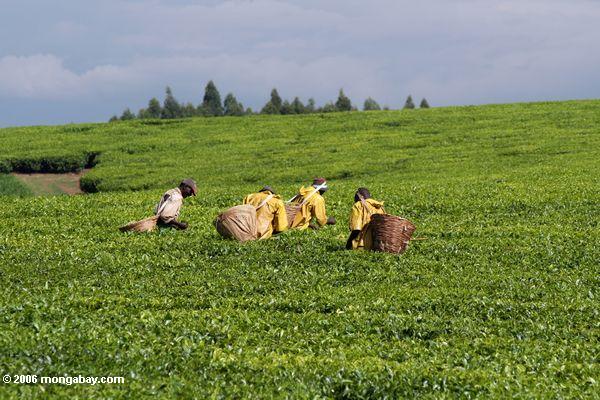Traditional crop varieties and food security
APPRECIATING THE BENEFITS OF PLANT BIODIVERSITY
By John Tuxill
From "State of the World, 1999." Copyright í 1999, Worldwatch Institute. Publication is available from Worldwatch Institute, 1776 Massachusetts Avenue, N.W., Washington, D.C. 20036. http://www.worldwatch.org

Laos. All photos courtesy of Mongabay.com
Traditional crop varieties are equally indispensable for global food security. Subsistence farmers around the world continue to grow primarily either landraces or locally adapted versions of professionally bred seed. Such small-scale agriculture produces 15-20 percent of the world's food supply, is predominantly performed by women, and provides the daily sustenance of roughly 1.4 billion rural poor. Moreover, landraces have contributed the genetic infrastructure of the intensively bred crop varieties that feed the rest of us. More than one third of the U. S. wheat crop owes its productivity to landrace genes from Asia and other regions, a contribution worth at least $500 million annually.
As we enter the next millennium, agricultural biodiversity faces an uncertain future. The availability of wild foods and populations of many wild relatives of crops is declining as wildlands are converted to human-dominated habitats and as hedgerows, fallow fields, and other secondary habitats decline within traditional agricultural landscapes. In the United States, two thirds of all rare and endangered plants are close relatives of cultivated species. If these species go extinct, a pool of potentially crucial future benefits for global agriculture will also vanish.

Kenya
There is also grave concern for the old crop landraces. By volume, the world's farmers now grow more sorghum, spinach, apples, and other crops than ever before, but they grow fewer varieties of each crop. Crop diversity in industrial nations has undergone a massive turnover this century; the proportion of varieties grown in the United States before 1904 but no longer present in either commercial agriculture or any major seed storage facility ranges from 81 percent for tomatoes to over 90 percent for peas and cabbages. Figures are less comprehensive for developing countries, but China is estimated to have gone from growing 10,000 wheat varieties in 1949 to only 1,000 by the 1970s, while just 20 percent of the corn varieties cultivated in Mexico in the 1930s can still be found there -- an alarming decline for the cradle of corn.
Crop varieties are lost for many reasons. Sometimes an extended drought destroys harvests and farmers must consume their planting seed stocks just to survive. Long-term climate change can also be a problem. In Senegal, two decades of below-normal rainfall created a growing season too short for traditional rice varieties to produce good yields. When fast-maturing rice cultivars became available through development aid programs, women farmers rapidly adopted them because of the greater harvest security they offered.

In the majority of cases, however, farmers voluntarily abandon traditional seeds when they adopt new varieties, change agricultural practices, or move out of farming altogether. In industrial countries, crop diversity has declined in concert with the steady commercialization and consolidation of agriculture this century: fewer family farmers, and fewer seed companies offering fewer varieties for sale, mean fewer crop varieties planted in fields or saved after harvest. The seed supply industry is now dominated by multinational corporations; increasingly, the same companies that sell fertilizers and pesticides to farmers now also promote seeds bred to use those products.
In most developing countries, diversity losses were minimal until the 1960s, when the famed international agricultural development program known as the Green Revolution introduced new high-yielding varieties of wheat, rice, corn, and other major crops. Developed to boost food self-sufficiency in famine-prone countries, the Green Revolution varieties were widely distributed, often with government subsidies to encourage their adoption, and displaced landraces from many prime farmland areas.

Healing herbs in Kenya
In areas where agriculture is highly mechanized and commercialized, crops now exhibit what the U.N. Food and Agriculture Organization (FAO) politely calls an "impressively uniform" genetic base. A survey of nine major crops in the Netherlands found that the three most popular varieties for each crop covered 81-99 percent of the respective areas planted. Such patterns have also emerged on much of the developing world's prime farmland. One single wheat variety blanketed 67 percent of Bangladesh's wheat acreage in 1983 and 30 percent of India's the following year.
The ecological risks we take in adopting such genetic uniformity are enormous, and keeping them at bay requires an extensive infrastructure of agricultural scientists and extension workers -- as well as all too frequent applications of pesticides and other potent agrochemicals. A particularly heavy burden falls on professional plant breeders, who are now engaged in a relay race to develop ever more robust crop varieties before those already in monoculture succumb to evolving pests and diseases, or to changing environmental conditions.

Tea in Uganda
Breeders started this race earlier this century with a tremendous genetic endowment at their disposal, courtesy of nature and generations of subsistence farmers. Despite major losses, this wellspring is still far from empty -- estimates are that plant breeders have used only a small fraction of the varietal diversity present in crop gene banks (facilities that store seeds under cold, dry conditions that can maintain seed viability for decades). At the same time, we can never be sure that what is already stored will cover all our future needs. When grassy stunt virus began attacking high-yielding Asian rices in the 1970s, breeders located genetic resistance to the disease in only a single collection of one population of a wild rice species in Uttar Pradesh, India -- and that population has never been found again since. Conserving and reinvigorating biodiversity in agricultural landscapes remains essential for achieving global food security.
Previous | Next



